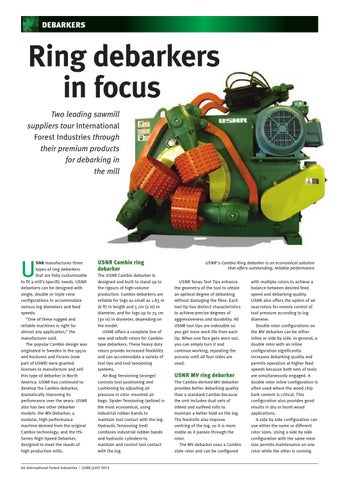IFI_PG66_68_Debarkers_HR 05/07/2013 06:32 Page 66
DEBARKERS
Ring debarkers in focus Two leading sawmill suppliers tour International Forest Industries through their premium products for debarking in the mill
U
SNR manufactures three types of ring debarkers that are fully customisable to fit a mill’s specific needs. USNR debarkers can be designed with single, double or triple rotor configurations to accommodate various log diameters and feed speeds. “One of these rugged and reliable machines is right for almost any application,” the manufacturer said. The popular Cambio design was originated in Sweden in the 1950s and Kockums and Forano (now part of USNR) were granted licenses to manufacture and sell this type of debarker in North America. USNR has continued to develop the Cambio debarker, dramatically improving its performance over the years. USNR also has two other debarker models: the MV Debarker, a modular, high performance machine derived from the original Cambio technology; and the HSSeries High-Speed Debarker, designed to meet the needs of high production mills.
USNR Cambio ring debarker The USNR Cambio debarker is designed and built to stand up to the rigours of high-volume production. Cambio debarkers are reliable for logs as small as 1.83 m (6 ft) in length and 5 cm (2 in) in diameter, and for logs up to 75 cm (30 in) in diameter, depending on the model. USNR offers a complete line of new and rebuilt rotors for Cambiotype debarkers. These heavy duty rotors provide increased flexibility and can accommodate a variety of tool tips and tool tensioning systems. Air-Bag Tensioning (orange) controls tool positioning and cushioning by adjusting air pressure in rotor mounted air bags. Spider Tensioning (yellow) is the most economical, using industrial rubber bands to maintain tool contact with the log. Hydraulic Tensioning (red) combines industrial rubber bands and hydraulic cylinders to maintain and control tool contact with the log.
66 International Forest Industries | JUNE/JULY 2013
USNR’s Cambio Ring debarker is an economical solution that offers outstanding, reliable performance USNR Tenax Tool Tips enhance the geometry of the tool to obtain an optimal degree of debarking without damaging the fibre. Each tool tip has distinct characteristics to achieve precise degrees of aggressiveness and durability. All USNR tool tips are indexable so you get more work life from each tip. When one face gets worn out, you can simply turn it and continue working, repeating the process until all four sides are used.
USNR MV ring debarker The Cambio-derived MV debarker provides better debarking quality than a standard Cambio because the unit includes dual sets of infeed and outfeed rolls to maintain a better hold on the log. The feedrolls also improve centring of the log, so it is more stable as it passes through the rotor. The MV debarker uses a Cambio style rotor and can be configured
with multiple rotors to achieve a balance between desired feed speed and debarking quality. USNR also offers the option of air seal rotors for remote control of tool pressure according to log diameter. Double rotor configurations on the MV debarker can be either inline or side by side. In general, a double rotor with an inline configuration significantly increases debarking quality and permits operation at higher feed speeds because both sets of tools are simultaneously engaged. A double rotor inline configuration is often used where the wood chip bark content is critical. This configuration also provides good results in dry or burnt wood applications. A side by side configuration can use either the same or different rotor sizes. Using a side by side configuration with the same rotor size permits maintenance on one rotor while the other is running.
